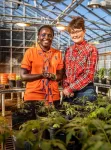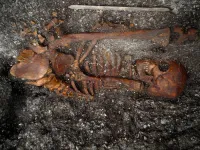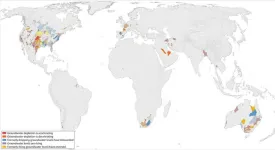(Press-News.org) Plants produce a range of chemicals known as volatile organic compounds that influence their interactions with the world around them. In a new study, researchers at the University of Illinois Urbana-Champaign investigated how the type and amount of these VOCs change based on different features of tomato plants.
The smell of cut grass is one of the defining fragrances of summer. Smells like that are one of the ways plants signal their injury. Because they cannot run away from danger, plants have evolved to communicate with each other using chemical signals. They use VOCs for a variety of reasons: to help prepare their own defenses, to warn each other of threats, to recruit beneficial soil microbes that can help plants grow, and to alert insect predators that there is a pest chewing on that plant’s leaves.
“When a caterpillar chews on a leaf, the plant sends out a signal that calls out to the caterpillar’s predators. It’s like a billboard that tells them where lunch is,” said Erinn Dady, a graduate student in the Ngumbi lab.
Studying the factors that influence VOC emissions, therefore, is key to understanding plant health. In the past, other studies have looked at how soil microbes like arbuscular mycorrhizal fungi or caterpillars or the variety of tomato plant can influence VOCs. In the current study, the researchers studied the collective influence of all these factors on plant chemistry using four tomato varieties—two heirlooms and two hybrids.
“Previous studies looked at tomato varieties that are grown conventionally at a massive scale for processing, and are not usually grown by small farmers, so we decided to ask Illinois farmers what they grow. Based on their feedback, we chose tomato varieties that are commonly grown in central Illinois,” Dady said. The hybrids used were Mountain Fresh and Valley Girl, and the organic heirlooms were Amish Paste and Cherokee Purple.
The researchers compared the responses of untreated plants to those that had been exposed to AMF, caterpillars, or both. They studied the VOCs by enclosing the eight-week-old tomato plants with an odor-blocking oven bag for an hour. They drew out the air around the plants and analyzed the different chemicals produced by each plant using gas chromatography-mass spectrophotometry.
The AMF and the caterpillars, separately, decreased the volatile emissions in all four varieties of tomato plants. Their effect when present together was minimal compared to the effects when either one was present.
Although it is unclear why the beneficial fungal associations decreased the VOCs, it is concerning that the plants were not as responsive to the caterpillars. Furthermore, the hybrid tomatoes emitted lower quantities of volatiles compared to the heirloom tomatoes. “Heirloom tomatoes—the big, juicy tomatoes we all love—are bred for flavor. Meanwhile, hybrids are grown for large scale conventional production, which comes at a cost to the plant,” said Esther Ngumbi (CIS/MMG), an assistant professor of integrative biology. “Our work suggests that we are compromising plant defenses through our breeding processes.”
The plants were also evaluated based on their growth both above the ground and in the soil. The researchers found that plants that had associations with the fungi had higher leaf biomass and more complex root structures.
“AMF form partnerships in over 80% of the land plants, setting up a trade where the fungi extract nutrients from the soil in exchange for carbon from plants,” Dady said. “We found that, especially in Cherokee Purple, AMF may confer additional benefits, including enhanced growth and greater emission of VOCs.”
Surprisingly, the plants that were treated with caterpillars had greater plant growth. “These plants had more biomass in both their roots and above the ground, which seems counterintuitive because they’ve actively been eaten. I would assume they would have less biomass,” Dady said. “It is possible that the caterpillars triggered a growth response, similar to how you prune a tree to make it produce new growth.”
The researchers are interested in further investigating the growth response to caterpillars. “It’s possible that the plants decided that the number of caterpillars we were using were not sufficient to be considered a threat and that’s why they kept growing. It is also possible that the caterpillars weren’t hungry enough to cause enough damage,” Ngumbi said.
“There’s a lot going on behind the scenes that we don’t yet understand. For example, we are barely scratching the surface in understanding the role of different microbes,” Dady said. “People tend to think that plants are not intelligent, but our studies have shown that they are actively responding to the environment around them using chemistry.”
“We are trying to spread the gospel of plant chemistry, it’s the language plants use to communicate and we are excited to learn more,” Ngumbi said.
The study “Plant Variety, Mycorrhization, and Herbivory Influence Induced Volatile Emissions and Plant Growth Characteristics in Tomato” was published in the Journal of Chemical Ecology and can be found at https://doi.org/10.1007/s10886-023-01455-w. The work was funded by the University of Illinois Urbana-Champaign.
END
Talking tomatoes: How their communication is influenced by enemies and friends
2024-01-24
ELSE PRESS RELEASES FROM THIS DATE:
Thomas A. Rando, MD, PhD, elected President of the Board of Directors of the American Federation for Aging Research (AFAR)
2024-01-24
The American Federation for Aging Research (AFAR), a national, nonprofit whose mission is to advance and support healthy aging through biomedical research, is pleased to announce the election of Thomas A. Rando, MD, PhD, as President of the Board of Directors in December 2023.
Dr. Rando is currently the Director of the Eli and Edythe Broad Center of Regenerative Medicine and Stem Cell Biology at UCLA, where he is a professor of Neurology and Molecular, Cell, and Developmental Biology. Previously, he ...
Fast-charging lithium battery seeks to eliminate ‘range anxiety’
2024-01-24
ITHACA, N.Y. – Cornell University engineers have created a new lithium battery that can charge in under five minutes – faster than any such battery on the market – while maintaining stable performance over extended cycles of charging and discharging.
The breakthrough could alleviate “range anxiety” among drivers who worry electric vehicles cannot travel long distances without a time-consuming recharge.
“Range anxiety is a greater barrier to electrification in transportation than any of the other barriers, like cost and capability of batteries, and we have identified a pathway to eliminate it using rational electrode designs,” said Lynden ...
Chemistry professor R. Graham Cooks expands research of water droplet interfaces that offer the secret ingredient for building life
2024-01-24
R. Graham Cooks, the Henry B. Hass Distinguished Professor of Chemistry, and his postdoctoral researcher Lingqi Qiu have experimental evidence that the key step in protein formation can occur in droplets of pure water, and have recently published these findings in the Proceedings of the National Academy of Sciences (PNAS).
In this key step, amino acids are dehydrated (they lose water) even though they are in a water solution, a paradox that is resolved by the fact that these droplet surfaces are unusually dry and highly ...
Brain mechanism teaches mice to avoid bullies
2024-01-24
Like humans, mice live in complex social groups, fight over territory and mates, and learn when it is safer to avoid certain opponents. After losing even a brief fight, the defeated animals will flee from the mice that hurt them for weeks afterward, a new study shows.
Led by researchers at NYU Grossman School of Medicine, the study reveals that such “retreating behavior” is influenced by a distinct area on the underside of the hypothalamus, a part of the brain that controls hunger, sleep, and levels of many hormones. The team had previously found that this special region, called the anterior ventrolateral part of the ventromedial hypothalamus (aVMHvl), ...
New tool reveals gene behavior in bacteria
2024-01-24
Bacterial infections cause millions of deaths each year, with the global threat made worse by the increasing resistance of the microbes to antibiotic treatments. This is due in part to the ability of bacteria to switch genes on and off as they sense environmental changes, including the presence of drugs. Such switching is accomplished through transcription, which converts the DNA in genes into its chemical cousin in mRNA, which guides the building of proteins that make up the microbe’s structure.
For this ...
Chemists use the blockchain to simulate over 4 billion chemical reactions essential to the origins of life
2024-01-24
Cryptocurrency is usually “mined” through the blockchain by asking a computer to perform a complicated mathematical problem in exchange for tokens of cryptocurrency. But in research appearing in the journal Chem on January 24, a team of chemists have repurposed this process, asking computers to instead generate the largest network ever created of chemical reactions which may have given rise to prebiotic molecules on early Earth.
This work indicates that at least some primitive forms of metabolism might have emerged without the involvement of ...
Fracture risk among living kidney donors 25 years after donation
2024-01-24
About The Study: This survey study found a reduced rate of overall fractures but an excess of vertebral fractures among living kidney donors compared with controls after a mean follow-up of 25 years. Treatment of excess vertebral fractures with dietary supplements such as vitamin D3 may reduce the numbers of vertebral fractures and patient morbidity.
Authors: Rajiv Kumar, M.B.B.S., of the Mayo Clinic in Rochester, Minnesota, is the corresponding author.
To access the embargoed study: Visit our For The Media website at this link https://media.jamanetwork.com/
(doi:10.1001/jamanetworkopen.2023.53005)
Editor’s ...
Contrasting characteristics and outcomes of sports-related and non–sports-related traumatic brain injury
2024-01-24
About The Study: In this study of 4,360 patients with traumatic brain injury (TBI), functional limitations six months after injury were common after sports-related TBI, even mild sports-related TBI. Persisting impairment was evident in the sports-related TBI group despite better recovery compared with non–sports-related TBI on measures of mental health and post-concussion symptoms. These findings caution against taking an overoptimistic view of outcomes after sports-related TBI, even if the initial injury appears mild.
Authors: Lindsay Wilson, ...
Syphilis-like diseases were already widespread in America before the arrival of Columbus
2024-01-24
Researchers at the Universities of Basel and Zurich have discovered the genetic material of the pathogen Treponema pallidum in the bones of people who died in Brazil 2,000 years ago. This is the oldest verified discovery of this pathogen thus far, and it proves that humans were suffering from diseases akin to syphilis – known as treponematoses – long before Columbus’s discovery of America. The new findings, published in the scientific journal Nature, call into question previous theories concerning the spread of syphilis ...
Global groundwater depletion is accelerating, but is not inevitable
2024-01-24
(Santa Barbara, Calif.) — Groundwater is rapidly declining across the globe, often at accelerating rates. Writing in the journal Nature, UC Santa Barbara researchers present the largest assessment of groundwater levels around the world, spanning nearly 1,700 aquifers. In addition to raising the alarm over declining water resources, the work offers instructive examples of where things are going well, and how groundwater depletion can be solved. The study is a boon for scientists, policy makers and resource managers working to understand global groundwater dynamics.
“This study was driven by curiosity. We wanted to better understand the state of global ...



